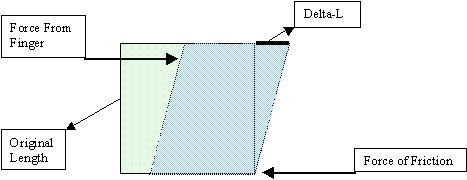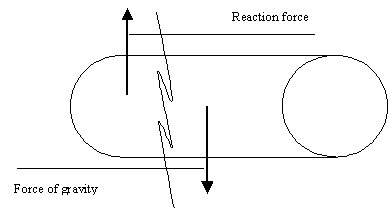
| MadSci Network: Physics |
Hi Lee,
Actually, a chalk that falls horizontally doesn't necessarily break into 3 pieces, as I found out after a little experimentation, much to the dismay of our supply room. The reason a rigid object (which, for all intents and purposes, is exactly what our piece of chalk is) breaks at all has to do with many factors. Let's see if we can discover some of these reasons.
All rigid bodies are, to a certain extent, elastic. That is, they can change their shape, or, more correctly, their dimensions when subjected to external forces. Any external force that's applied to an object is called a stress (more properly, stress is defined as F/A). This stress can affect the rigid body in one of three ways:

The reason these shearing forces are particularly interesting for us is that I think this is what happens to your chalk. When you drop the chalk horizontally and it contacts the ground, there is a force directed upward (the reaction force) which is opposed by the downward force (the force of gravity). The result is that you have two oppositely directed forces which cause the chalk to shear. You can even see this in the pieces of chalk that are left over from the experiment. Now, to see why it doesn't necessarily break apart into 3 pieces, we need to quantify our shearing forces. Luckily for us, someone else has already done this work; shearing forces are represented by the following relation (from D. Giancoli's Physics for Scientists and Engineers):
(Delta-L) = (F*Lo)/(G*A)
where G is the shear modulus for that material, A is the surface area parallel to the applied force and the (Delta-L) is directed perpendicular to Lo. Now for our case, we're making a lot of assumptions and idealizations (i.e., it's in equilibrium, no torques, etc.) but basically this should hold true. When the chalk is dropped, it will land slightly off center. The reaction force will be directed upwards from the point of contact (depending on it's initial position when you let go of it) but the force of gravity will be directed straight down from the center of mass, as in the picture below:

This offset of forces will lead to the shear. And, as we see in our equation above, the amount of stretch, or (Delta-L), depends on the Force (how high above the ground it was), G (which is approximately 107 N/m2 for chalk), A (how big or small the surface area of the chalk is), and L (the original length of the chalk). All these factors will combine together to determine how much the chalk deforms. And, if the the force is great enough, the deformation will be large enough to cause the chalk to fracture, or break. After the first break, I imagine the bigger piece hits the ground on the other side, and a reverse of the above causes a second fracture, hence the three pieces in your particular case.
To see that chalk won't always magically break apart into 3 pieces, take 2 equal pieces of chalk; drop one and see if it breaks into 3 pieces. If it does, cut the other piece of chalk so it's approximately half of it's original length and then drop it again. The second piece of chalk will probably break into 2 pieces, rather than three (that is, if it's not so small that it doesn't break at all; in other words, if the length is made really small, then the deformation will be correspondingly small and if the deformation, or strain, isn't great enough to exceed the breaking point, then the chalk won't fracture at all). In conclusion, many factors determine how a rigid body fractures, chief among which are: the length of the body, it's dimensions (e.g., surface area), and the external force that's applied (e.g., the height from which you drop the chalk). Well, I hope that helps... as usual, if you would like to discuss anything further or have any corrections, please feel free to drop me a line at rickys@sethi.org and I'd be more than happy to go into it at greater length (bad pun intended :).
Best regards,
Rick.
[Moderator note: If you have a longer than normal piece of chalk it makes sense
that it would probably break into more than 3 pieces when dropped.]
Try the links in the MadSci Library for more information on Physics.